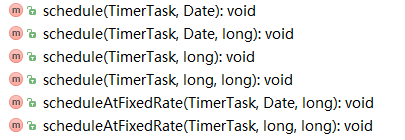schedule与scheduleAtFixedRate之Timer源码分析
执行Timer任务调度方法有如下几种:

这些方法最后调用的都是这个方法:
private void sched(TimerTask task, long time, long period)
这个方法的作用是将task放入Timer实例的共享变量queue(TaskQueue类型)中。源码如下:
private void sched(TimerTask task, long time, long period) {
if (time < 0)
throw new IllegalArgumentException("Illegal execution time.");
// Constrain value of period sufficiently to prevent numeric
// overflow while still being effectively infinitely large.
if (Math.abs(period) > (Long.MAX_VALUE >> 1))
period >>= 1;
synchronized(queue) {
if (!thread.newTasksMayBeScheduled)
throw new IllegalStateException("Timer already cancelled.");
synchronized(task.lock) {
if (task.state != TimerTask.VIRGIN)
throw new IllegalStateException(
"Task already scheduled or cancelled");
task.nextExecutionTime = time;
task.period = period;
task.state = TimerTask.SCHEDULED;
}
queue.add(task);
if (queue.getMin() == task)
queue.notify();
}
}
TaskQueue按照一个“完全二叉树堆”来进行排序,完全二叉树堆的中根节点的值最大(或者最小),每节点的值大于(或者小于)其两个子节点。
queue.add(task)时首先将该任务放到队列最后,会发生“上浮”动作,最终保持完全二叉树堆的根节点存放task.nextExecutionTime最小的那个task,如果要执行任务直接从TaskQueue的根节点获取那个值执行,执行完任务后从队列中移除。
这篇文章以图文的方式对二叉树堆算法讲解的很清晰 http://weixin.niurenqushi.com/article/2016-06-17/4326390.html,可以参考一下。
回到源码,sched(TimerTask task, long time, long period) 方法会将一个任务加入到TaskQueue队列后,如果这个任务在队列中的根节点(也就是nextExecutionTime最小的那个task),那就发出notify通知,激活其他占用了该任务由于wait()而阻塞状态的线程。
那这个线程主要涉及那一块呢?答案是Timer的线程体,源码如下:
public void run() {
try {
mainLoop();
} finally {
// Someone killed this Thread, behave as if Timer cancelled
synchronized(queue) {
newTasksMayBeScheduled = false;
queue.clear(); // Eliminate obsolete references
}
}
}
/**
* The main timer loop. (See class comment.)
*/
private void mainLoop() {
while (true) {
try {
TimerTask task;
boolean taskFired;
synchronized(queue) {
// Wait for queue to become non-empty,等待被notify激活
while (queue.isEmpty() && newTasksMayBeScheduled)
queue.wait();
if (queue.isEmpty())
break; // Queue is empty and will forever remain; die
// Queue nonempty; look at first evt and do the right thing
long currentTime, executionTime;
task = queue.getMin();
synchronized(task.lock) {
if (task.state == TimerTask.CANCELLED) {
queue.removeMin();
continue; // No action required, poll queue again
}
currentTime = System.currentTimeMillis();
executionTime = task.nextExecutionTime;
// 任务执行时间已经到达
if (taskFired = (executionTime<=currentTime)) {
if (task.period == 0) { // 如果period=0,则任务进行一次便结束,并移出队列
queue.removeMin();
task.state = TimerTask.EXECUTED;
} else { // 设置下一次执行的时间
// task.period<0 对应 scheduleAtFixedRate 方法
// task.period>0 对应 schedule 方法
queue.rescheduleMin(
task.period<0 ? currentTime - task.period
: executionTime + task.period);
}
}
}
// 任务执行时间没到,等待,直到下一次执行时间大于当前时间
if (!taskFired)
queue.wait(executionTime - currentTime);
}
// 执行任务时间到达,开始执行任务,没有加锁,并发执行
if (taskFired) // Task fired; run it, holding no locks
task.run();
} catch(InterruptedException e) {
}
}
}




